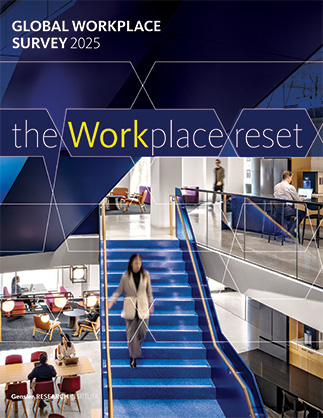Human connection and collective work are fundamental elements of getting work done. Our data shows that in the U.S., time spent working with others in person has increased since the pandemic, while socializing has nearly doubled — a trend observed in most of the 15 countries we surveyed. These shared experiences strengthen relationships, reinforce cultural norms, and foster a sense of community among colleagues.
This global report presents insights from the Gensler Research Institute’s latest survey of more than 16,800 full-time office workers across 15 countries and 10 industries. Our goal was to uncover what employees value most, what they need from the office/work environment, and how workplaces can be better designed to support all forms of in-person work. Taking a human-centered approach, we explored how employees perceive their workday — from office design and available space types, to team dynamics, desired amenities, and preferred work experiences beyond the traditional office.
Our 2025 Global Workplace Survey reveals how great design starts with people in mind. That means creating a workplace that can help people get work done — both individually and collectively. And it means designing for a workforce that thrives on meaningful interactions — creating high-performance workplaces where an organization and its employees accomplish their shared goals together.
How and where employees work varies across country, industry, age, and role.
We measure how people work across five work modes.
Gensler has measured how people work for 20 years. We study how employees work across five work modes: working alone, working with others in-person, working with others virtually, learning/professional development, and socializing, which includes connecting and networking. A key finding reveals that across the globe, time spent working with others in-person continues to increase while working alone continues to steadily decrease. This foundational research provides new insights into how the nature of work and employee expectations are changing in 2025 and beyond.
IN-PERSON
Today’s workplaces must evolve with employee work patterns.
Understanding how and where employees work, and what they value, is essential to redefining how to measure high-performing workplaces. Gensler’s latest Global Workplace Survey explores how employees work differently across demographics, varying by country, industry, age, and role. These insights form the basis for designing great workplace experiences that respond to the current needs of today’s workforce.
Global Workplace Survey 2025 Methodology
The Gensler Research Institute conducted an anonymous, panel-based survey of 16,809 full-time office workers across 15 countries between August 26, and December 3, 2024. The survey was deployed using a third-party panel provider. At the time of data collection, all respondents were required to be full-time employed knowledge workers at a company, organization, or firm of at least 100+ employees, within 10 designated industry segments. Respondents were also required to work in an office environment at least some of the time. Respondents represented a broad cross-section of demographics, including job role, company size, age, commuting distances, living situation and geographical location across six global regions.

Download Gensler’s Global Workplace Survey 2025 to learn how to convert our knowledge of how employees work into design outcomes that can elevate workplace performance from good to great.